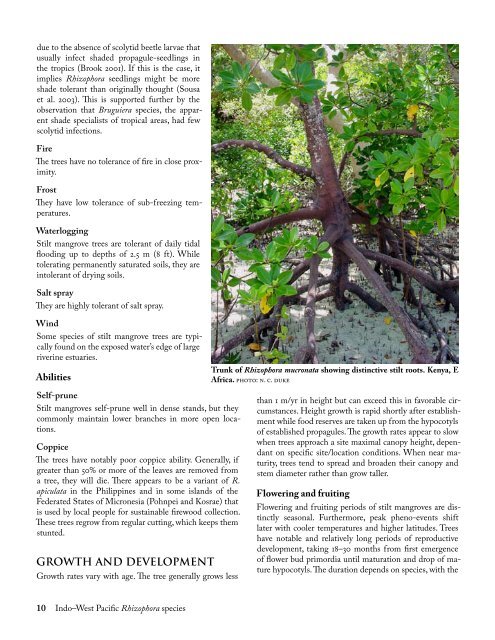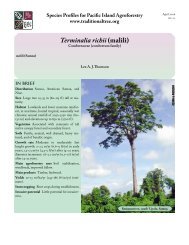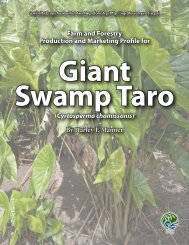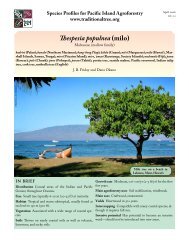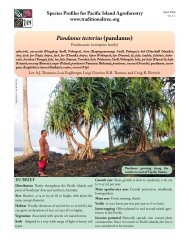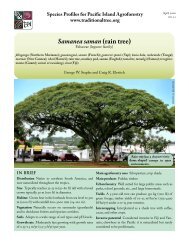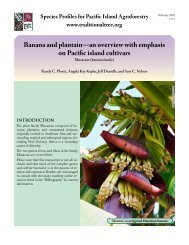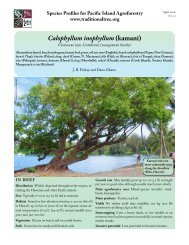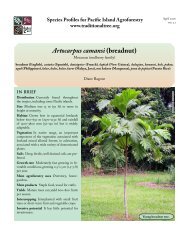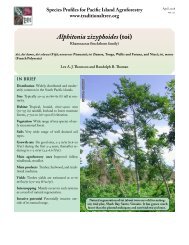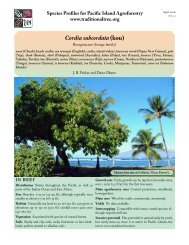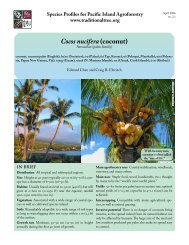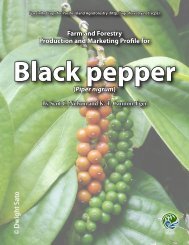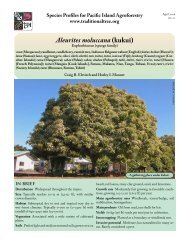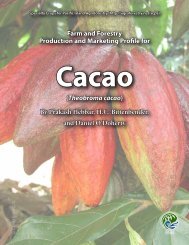Rhizophora apiculata, R. mucronata, R. stylosa, R ... - Agroforestry Net
Rhizophora apiculata, R. mucronata, R. stylosa, R ... - Agroforestry Net
Rhizophora apiculata, R. mucronata, R. stylosa, R ... - Agroforestry Net
Create successful ePaper yourself
Turn your PDF publications into a flip-book with our unique Google optimized e-Paper software.
due to the absence of scolytid beetle larvae that<br />
usually infect shaded propagule-seedlings in<br />
the tropics (Brook 2001). If this is the case, it<br />
implies <strong>Rhizophora</strong> seedlings might be more<br />
shade tolerant than originally thought (Sousa<br />
et al. 2003). This is supported further by the<br />
observation that Bruguiera species, the apparent<br />
shade specialists of tropical areas, had few<br />
scolytid infections.<br />
Fire<br />
The trees have no tolerance of fire in close proximity.<br />
Frost<br />
They have low tolerance of sub-freezing temperatures.<br />
Waterlogging<br />
Stilt mangrove trees are tolerant of daily tidal<br />
flooding up to depths of 2.5 m (8 ft). While<br />
tolerating permanently saturated soils, they are<br />
intolerant of drying soils.<br />
Salt spray<br />
They are highly tolerant of salt spray.<br />
Wind<br />
Some species of stilt mangrove trees are typically<br />
found on the exposed water’s edge of large<br />
riverine estuaries.<br />
Abilities<br />
Self-prune<br />
Stilt mangroves self-prune well in dense stands, but they<br />
commonly maintain lower branches in more open locations.<br />
Coppice<br />
The trees have notably poor coppice ability. Generally, if<br />
greater than 50% or more of the leaves are removed from<br />
a tree, they will die. There appears to be a variant of R.<br />
<strong>apiculata</strong> in the Philippines and in some islands of the<br />
Federated States of Micronesia (Pohnpei and Kosrae) that<br />
is used by local people for sustainable firewood collection.<br />
These trees regrow from regular cutting, which keeps them<br />
stunted.<br />
GROWTH AND DEVELOPMENT<br />
Growth rates vary with age. The tree generally grows less<br />
10 Indo–West Pacific <strong>Rhizophora</strong> species<br />
Trunk of <strong>Rhizophora</strong> <strong>mucronata</strong> showing distinctive stilt roots. Kenya, E<br />
Africa. photo: N. C. Duke<br />
than 1 m/yr in height but can exceed this in favorable circumstances.<br />
Height growth is rapid shortly after establishment<br />
while food reserves are taken up from the hypocotyls<br />
of established propagules. The growth rates appear to slow<br />
when trees approach a site maximal canopy height, dependant<br />
on specific site/location conditions. When near maturity,<br />
trees tend to spread and broaden their canopy and<br />
stem diameter rather than grow taller.<br />
Flowering and fruiting<br />
Flowering and fruiting periods of stilt mangroves are distinctly<br />
seasonal. Furthermore, peak pheno-events shift<br />
later with cooler temperatures and higher latitudes. Trees<br />
have notable and relatively long periods of reproductive<br />
development, taking 18–30 months from first emergence<br />
of flower bud primordia until maturation and drop of mature<br />
hypocotyls. The duration depends on species, with the


